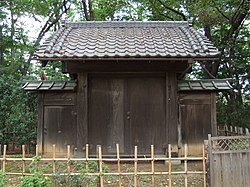Iwatsuki Castle
| Iwatsuki Castle | |
|---|---|
| 岩槻城 | |
| Iwatsuki-ku, Saitama, Saitama Prefecture, Japan | |

Surviving rear gate of Iwatsuki Castle
|
|
| Coordinates | Coordinates: 35°57′4.85″N 139°42′36.86″E / 35.9513472°N 139.7102389°E |
| Type | flatland-style Japanese castle |
| Site information | |
| Open to the public |
yes |
| Site history | |
| Built | Muromachi period |
| In use | Muromachi period to Edo period |
| Demolished | 1871 |
Iwatsuki Castle (岩槻城 Iwatsuki-jō?) is a Japanese castle located in Iwatsuki-ku, Saitama, in Saitama Prefecture, Japan. At the end of the Edo period, Tateyama Castle was home to the Ōoka clan, daimyō of Iwatsuki Domain, however the castle dates from the Muromachi period and was inhabited by many samurai lords over its history. During the Edo period, the name of the castle was written as “岩付城”. It was also known as "White Crane Castle" (白鶴城 Hakutsuru-jō?) or "Floating Castle" (浮城 Uki-jō?). The site of the castle is a Saitama Prefectural Historic Monument.
The castle was located in the Kantō Plain near the northern border of former Musashi Province, and made use of a bend in the former location of the Arakawa River as part of its defenses to the north and east, and a swamp to the west and south. Large scale anti-flood construction diverted the main flow of the Arakawa River in the mid-Edo period, and the current location of the castle is some distance from the modern-day river. The main bailey, second enclosure and third enclosure were surrounded by very wide swampy moats, with the castle town located to the southwest.
...
Wikipedia
